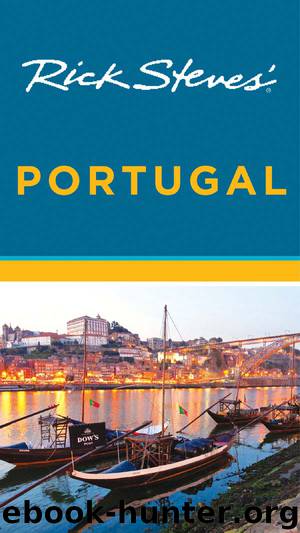Rick Steves' Portugal by Rick Steves

Author:Rick Steves
Language: eng
Format: epub
Publisher: Avalon Travel
Published: 2013-03-14T16:00:00+00:00
Museum of Évora: This museum stands where the Roman forum once sprawled. An excavated section of the forum is in the museum’s courtyard, surrounded by a delightful mix of Roman finds, medieval statuary, and 16th-century Portuguese, Flemish, Italian, and Spanish paintings (€4, free Sun before 14:00, open Tue-Sun 10:00-18:00, closed Mon, English info sheets, Largo Conde de Vila Flor, tel. 266-702-604, http://museudevora.imc-ip.pt). The museum also contains megalithic artifacts, including some found near Évora at the tomb known as the Anta Grande do Zambujeiro (described on here).
• Across the square from the museum is a white building with the top windows trimmed in yellow. This is the...
Tribunal of the Inquisition: This building may be closed for renovation when you visit. When finished, it will house a new modern art museum. The building itself stands as a reminder of Évora’s notorious past. Here, thousands of innocent people, many of them Moors and Jews, were tried and found guilty. After being condemned, the prisoners were taken in procession through the streets to be burned on the main square. In front of this building is a granite sculpture of a coffin with a body inside—a memorial to those who were killed.
• Go to the left of the Inquisition headquarters to find a little street called...
Rua de Vasco da Gama: Globetrotting da Gama lived on this street after he discovered the water route to India in 1498. His house is 30 yards down the street—find the smudged #15 on your right. Note the fine circa-1500 horseshoe-arch window above. Plans call for da Gama’s home to someday open to the public as a museum.
• Backtrack and turn right for the...
Cathedral: Located behind the museum, this cathedral was built after Giraldo’s conquest—on the site of the mosque. (For a description of the cathedral, its cloister, and its museum, see “Sights in Évora,” below.)
• Head downhill on the little street opposite the cathedral’s entrance. You’re walking on...
Rua 5 de Outubro: This shopping street, which has served this same purpose since Roman times, connects Évora’s main sights with its main square. The name of the road celebrates October 5, 1910, when Portugal shook off royal rule and became a republic. The street is lined with products of the Alentejo region: cork (even used as postcards), tile, leather, ironwork, and Arraiolos rugs (handmade, with a distinctive weave, in the nearby town of the same name).
On the shopping street, after you pass the intersection with Rua de Burgos, look left to see a blue shrine protruding from the wall of a building. The town built it as thanks to God for sparing it from the 1755 earthquake that devastated much of Lisbon. Ahead of you is the main square. The Chapel of Bones and town market are just a few blocks away on your left. But first, stop by the venerable Café Arcada, under the arcade near the church. Considered the best pastry shop in town (with the surliest staff), it serves good coffee and the local specialty: fresh, sweet cheese tarts (queijada, kay-ZHAH-duh, pre-pay at the bar).
Download
This site does not store any files on its server. We only index and link to content provided by other sites. Please contact the content providers to delete copyright contents if any and email us, we'll remove relevant links or contents immediately.
Annapurna by Maurice Herzog(3423)
Liar's Poker by Michael Lewis(3370)
A Forest Journey by John Perlin(3027)
Atlas Obscura by Joshua Foer(2898)
The Ogre by Doug Scott(2631)
Cuba by Lonely Planet(2577)
Photographic Guide to the Birds of Indonesia by Strange Morten;(2490)
Tokyo by Rob Goss(2389)
All Things Reconsidered by Bill Thompson III(2357)
The Splendid and the Vile by Erik Larson(2355)
Fatal Storm by Rob Mundle(2171)
A TIME OF GIFTS by Patrick Leigh Fermor(2156)
INTO THE WILD by Jon Krakauer(2153)
DK Eyewitness Top 10 Travel Guides Orlando by DK(2129)
Trail Magic by Trevelyan Quest Edwards & Hazel Edwards(2125)
Touching the Void by Joe Simpson(2090)
Top 10 Dubai and Abu Dhabi by DK Travel(2058)
Abbey in America by Murray John A(2050)
Lonely Planet Australia by Lonely Planet(2033)
